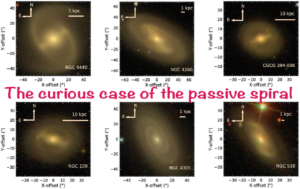Project area/S
- The Local Universe / The Distant Universe
Project Details
Spiral galaxies are known to be blue galaxies, constantly forming young stars. But there is also a small population of red spiral galaxies in the Local Universe. These galaxies do not show any evidence of recent star-formation activity, however, most of the mechanisms that are known to quench star-formation also lead to a morphological transformation, generally making quenched galaxies lose their spiral structures. So what makes these galaxies stop forming stars? How quickly are they quenched? Is there any connection between their evolution and the environment where they live? This project will seek to clarify these questions by characterising a sample of present-day passive spiral galaxies.
Utilising resolved integral field spectroscopy from the SAMI galaxy survey, the student will compare properties such as the age, metal content, degree of rotation, local environment, and orbital structures within their passive spiral sample. If time allows, the student will then select a sample of passive spirals from the EAGLE simulation, to compare the properties of observed galaxies with the simulated ones and to explore the quenching mechanisms these galaxies have undergone, connecting them with the properties observed. The result will be a comprehensive survey of how passive spiral galaxies quenched and whether they have any peculiar characteristics. The student will work with the Australia-wide SAMI galaxy survey team and learn about galaxy evolution through the use of optical spectroscopy and the analysis of integral field spectroscopic data cubes.
Student Attributes
Academic Background
Interest in observational astronomy and/or simulation (especially
extragalactic astronomy) and galaxy evolution preferable.
Computing Skills
Some Python experience (or similar programming language)
desirable.
Training Requirement
Python coding skills (plotting data in python and matplotlib),
LaTeX, how to perform a literature search for astronomy.
Project Timeline
- Week 1 Inductions and project introduction
- Week 2 Initial Presentation
- Week 3 Familiarization with SAMI data set, auxiliary data, the EAGLE simulation and literature. Learn what a data cube is, how to display using Python, and how to extract the required properties from SAMI maps files and from EAGLE.
- Week 4 Familiarization with SAMI data set, auxiliary data, the EAGLE simulation and literature.
- Week 5 Characterize properties of passive spiral dataset.
- Week 6 Characterize properties of passive spiral dataset (optional: select similar passive spirals in the EAGLE simulation).
- Week 7 Compare the SAMI data set with the EAGLE data set.
- Week 8 Make conclusions on how passive spiral galaxies quenched and whether they have any peculiar characteristics.
- Week 9 Final Presentation
- Week 10 Final Report

Images of passive spiral galaxies from the SAMI galaxy survey
